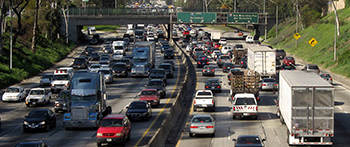2012 News & Events
Gasoline worse than diesel when it comes to some types of air pollution
9 March 2012

The exhaust fumes from gasoline vehicles contribute more to the production of a specific type of air pollution – secondary organic aerosols (SOA) – than those from diesel vehicles, according to a new study by scientists from ESRL, the Cooperative Institute for Research in Environmental Sciences (CIRES), and other colleagues.
"The surprising result we found was that it wasn't diesel engines that were contributing the most to the organic aerosols in LA," said CSD & CIRES scientist Roya Bahreini who led the study. "This was contrary to what the scientific community expected."
SOAs are tiny particles that are formed in air and make up typically 40-60 percent of the aerosol mass in urban environments. This is important because fine-particle pollution can cause human health effects, such as heart or respiratory problems.
Due to the harmful nature of these particles and the fact that they can also impact the climate and can reduce visibility, scientists want to understand how they form, Bahreini said. Researchers had already established that SOAs could be formed from gases released by gasoline engines, diesel engines, and natural sources-biogenic agents from plants and trees-but they had not determined which of these sources were the most important, she said. "We needed to do the study in a location where we could separate the contribution from vehicles from that of natural emissions from vegetation," Bahreini said.
Los Angeles proved to be an ideal location. Flanked by an ocean on one side and by mountains to the north and the east, it is, in terms of air circulation, relatively isolated, Bahreini said. At this location, the scientists made three weekday and three weekend flights with the NOAA WP-3D research aircraft during CalNex 2010, which hosted an arsenal of instruments designed to measure different aspects of air pollution. "Each instrument tells a story about one piece of the puzzle," she said. "Where do the particles come from? How are they different from weekday to weekend, and are the sources of vehicle emissions different from weekday to weekend?" she said.
From their measurements, the scientists were able to confirm, as expected, that diesel trucks were used less during weekends, while the use of gasoline vehicles remained nearly constant throughout the week. The team then expected that the weekend levels of SOAs would take a dive from their weekday levels, Bahreini said.
But that was not what they found.
Instead the levels of the SOA particles remained relatively unchanged from their weekday levels. Because the scientists knew that the only two sources for SOA production in this location were gasoline and diesel fumes, the study's result pointed directly to gasoline as the key source.
"The contribution of diesel to SOA is almost negligible," Bahreini said. "Even being conservative, we could deduce from our results that the maximum upper limit of contribution to SOA would be 20 percent."
That leaves gasoline contributing the other 80 percent or more of the SOA, Bahreini said. The finding was published online March 1 in Geophysical Research Letters. "While diesel engines emit other pollutants such as soot and nitrogen oxides, for organic aerosol pollution they are not the primary culprit," Bahreini said.
If the scientists were to apply their findings from the LA study to the rest of the world, a decrease in the emission of organic species from gasoline engines may significantly reduce SOA concentrations on a global scale as well. This suggests future research aimed at understanding ways to reduce gasoline emissions would be valuable.
The study was funded by the National Oceanic and Atmospheric Administration's Climate Change and Air Quality Programs, the California Air Resources Board and The National Science Foundation.
Bahreini, R., A.M. Middlebrook, J.A. de Gouw, C. Warneke, M.K. Trainer, C.A. Brock, H. Stark, S.S. Brown, W.P. Dubé, J.B. Gilman, K. Hall, J.S. Holloway, W.C. Kuster, A.E. Perring, A.S.H. Prevot, J.P. Schwarz, J.R. Spackman, S. Szidat, N.L. Wagner, R.J. Weber, P. Zotter, D.D. Parrish, Gasoline emissions dominate over diesel in formation of secondary organic aerosol mass, Geophysical Research Letters, doi:10.1029/2011GL050718, 2012.
Abstract
Although laboratory experiments have shown that organic compounds in both gasoline fuel and diesel engine exhaust can form secondary organic aerosol (SOA), the fractional contribution from gasoline and diesel exhaust emissions to ambient SOA in urban environments is poorly known. Here we use airborne and ground-based measurements of organic aerosol (OA) in the Los Angeles (LA) Basin, California made during May and June 2010 to assess the amount of SOA formed from diesel emissions. Diesel emissions in the LA Basin vary between weekdays and weekends, with 54% lower diesel emissions on weekends. Despite this difference in source contributions, in air masses with similar degrees of photochemical processing, formation of OA is the same on weekends and weekdays, within the measurement uncertainties. This result indicates that the contribution from diesel emissions to SOA formation is zero within our uncertainties. Therefore, substantial reductions of SOA mass on local to global scales will be achieved by reducing gasoline vehicle emissions.